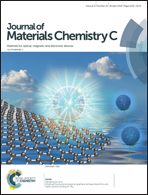Interfacial electronic states and self-formed p–n junctions in hydrogenated MoS2/SiC heterostructure†
Abstract
It is difficult to generate p–n junctions in atomically thin transition metal dichalcogenides (TMDs) because of the great challenge of selective doping. First-principles calculations demonstrate that the electronic states in monolayer MoS2 could be substantially tuned through contact with hydrogenated SiC sheets, as a result of interface-induced electronic doping. Specifically, monolayer MoS2 exhibits metallic characteristics when put in contact with the Si termination of SiC–H (MoS2/SiC–H), but exhibits ambipolar type polarization when in contact with the C termination of CSi–H (MoS2/CSi–H). Furthermore, monolayer MoS2 can be switched from p-type on H–Si terminations (MoS2/H–SiC and MoS2/H–SiC–H) to n-type on H–C terminations (MoS2/H–CSi and MoS2/H–CSi–H). Accordingly, p–n junctions can be generated in bilayer MoS2 if a fully hydrogenated monolayer SiC is inserted between the layers. In addition, the staggered band alignment of the top and bottom monolayers of MoS2 leads to considerable rectification of current. The results are helpful for the design of TMD based nanoelectronic devices.



 Please wait while we load your content...
Please wait while we load your content...